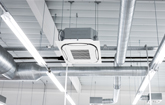NEW YORK, Jan. 7, 2025 /PRNewswire/ -- Report on how AI is redefining market landscape - The global residential HVAC market size is estimated to grow by USD 39.62 billion from 2025-2029, according to Technavio. The market is estimated to grow at a CAGR of 8.1% during the forecast period. Rise in demand for HVAC in construction industry is driving market growth, with a trend towards power evaluation software used in HVAC systems. However, issues in equipment related to hvac poses a challenge. Key market players include Carrier Global Corp., Daikin Industries Ltd., Danfoss AS, Electrolux group, Fujitsu Ltd., Gree Electric Appliances Inc. Of Zhuhai, Haier Smart Home Co. Ltd., Honeywell International Inc., Johnson Controls International Plc, Lennox International Inc., LG Corp., MIDEA Group Co. Ltd., National HVAC Service, Paloma Co. Ltd., Panasonic Holdings Corp., Samsung Electronics Co. Ltd., Systemair AB, Toshiba Corp., Trane Technologies Plc, and Whirlpool Corp..
Key insights into market evolution with AI-powered analysis. Explore trends, segmentation, and growth drivers- View Free Sample PDF
Residential Hvac Market Scope |
|
Report Coverage |
Details |
Base year |
2024 |
Historic period |
2019 - 2023 |
Forecast period |
2025-2029 |
Growth momentum & CAGR |
Accelerate at a CAGR of 8.1% |
Market growth 2025-2029 |
USD 39615.5 million |
Market structure |
Fragmented |
YoY growth 2022-2023 (%) |
7.5 |
Regional analysis |
APAC, Europe, North America, Middle East and Africa, and South America |
Performing market contribution |
APAC at 49% |
Key countries |
China, US, Germany, Japan, UK, Canada, India, South Korea, France, and Italy |
Key companies profiled |
Carrier Global Corp., Daikin Industries Ltd., Danfoss AS, Electrolux group, Fujitsu Ltd., Gree Electric Appliances Inc. Of Zhuhai, Haier Smart Home Co. Ltd., Honeywell International Inc., Johnson Controls International Plc, Lennox International Inc., LG Corp., MIDEA Group Co. Ltd., National HVAC Service, Paloma Co. Ltd., Panasonic Holdings Corp., Samsung Electronics Co. Ltd., Systemair AB, Toshiba Corp., Trane Technologies Plc, and Whirlpool Corp. |
Market Driver
The Residential HVAC market is experiencing significant growth due to increasing temperatures and consumer spending on heating equipment and air conditioners. Heat pumps are gaining popularity in cold regions with policy support for reducing greenhouse gas emissions. Smart equipment, including AI and automation, is becoming a trend with brands like Hisense, IntelliPro, CoolingXpert, and Sleep mode leading the way. Natural gas and electricity remain the primary energy sources, but global supply chain challenges and raw material costs impact delivery times. Air ventilators, air cleaners, and filtration systems are essential for maintaining indoor air quality, especially during the ongoing health crisis. Major market players like Carrier Corporation, Robert Bosch, and Mitsubishi Electric are investing in energy-efficient systems and novel technology solutions. Urbanization, thermal comfort, and automatic temperature control are key drivers in the forecast period. The commercial sector, including warehouses, buildings, and air handling units, is a significant market, along with the residential sector, construction activities, and the commercial sector in sectors like telecommunication, government, hotels, theme parks, private offices, government offices, sports centers, and convention centers. Low-interest rates and economic growth are boosting demand, particularly in developing economies. However, challenges like semiconductor chip shortages, government restrictions, and rising electricity consumption impact the market. Renewable energy capacity and integrated BAS units with sensor technology, communication systems, and user interfaces are essential for energy efficiency and facility management.
The residential HVAC market is experiencing a significant shift with the introduction of power evaluation software programs. Previously, HVAC contractors and homeowners had to manually check power bills and consumption data to determine if a new HVAC unit was necessary. However, advancements in technology have streamlined this process. Power evaluation software now enables contractors to easily access and analyze energy records, saving both time and money for clients. This software calculates the lifetime power usage and related statistics for HVAC systems, allowing for accurate comparisons to other options. By tracking performance, it calculates potential savings, providing valuable insights for informed decision-making in the residential HVAC market.
Request Sample of our comprehensive report now to stay ahead in the AI-driven market evolution!
Market Challenges
- The Residential HVAC market is facing several challenges in the current business environment. Heating equipment and air conditioners, including window units, through-the-wall models, and heat pumps, are in high demand due to growing temperatures. Consumer spending on HVAC systems is increasing, especially in cold regions. Policy support for greenhouse gas emissions reduction and the adoption of smart equipment, AI, and automation are key trends. Manufacturers like Hisense, IntelliPro, CoolingXpert, and Ensavior are innovating with Sleep mode, temperature control, and natural gas or electricity-powered solutions. However, the global supply chain is affected by raw materials availability and delivery time. Air ventilators, air cleaners, and filtration systems are gaining importance for indoor air quality, especially in the context of virus spread, ozone, and particle pollution. Major market players, such as Carrier Corporation, Robert Bosch, and Mitsubishi Electric, are investing in energy-efficient systems, R&D expenditures, and novel technology solutions. The market is semi-consolidated, with urbanization, thermal comfort, and energy efficiency driving demand in the forecast period. In the commercial sector, building HVAC, lighting controls, fire controls, and security controls are essential. The residential sector, telecommunication sector, and various industries, including hotels, theme parks, offices, and government offices, are major consumers. Government restrictions, semiconductor chips shortages, and economic factors like low-interest rates and economic growth also impact the market.
- The residential HVAC market consists of intricate heating and cooling systems, incorporating an array of software-based, electrical, and mechanical components. Over the years, these systems have grown more complex. However, this complexity brings potential challenges. For instance, neglected filters can degrade system performance, necessitating greater energy consumption and shortening the HVAC unit's lifespan. Regular maintenance is essential to mitigate these issues and ensure optimal system functionality.
Discover how AI is revolutionizing market trends- Get your access now!
Segment Overview
This residential hvac market report extensively covers market segmentation by
- Type
- 1.1 HVAC equipment
- 1.2 HVAC services
- Product
- 2.1 Air conditioning system
- 2.2 Heating system
- 2.3 Ventilating system
- Geography
- 3.1 APAC
- 3.2 Europe
- 3.3 North America
- 3.4 Middle East and Africa
- 3.5 South America
1.1 HVAC equipment- The residential HVAC market consists of heating, ventilation, and air conditioning equipment. Builders prioritize sustainable practices in constructing modern industrial spaces, leading to the adoption of energy-saving HVAC units and renewable energy sources. In Europe and North America, where temperatures are low, demand for heating equipment is high. Underfloor heating systems, an energy-efficient HVAC solution, are increasingly popular due to their space-saving design. Europe's stringent environmental regulations and focus on energy conservation drive the demand for underfloor heating systems and heat pumps. APAC's tropical climate necessitates a significant demand for air conditioners, with energy efficiency being a key consideration. Variable refrigerant volume (VRF) technology, which offers energy savings and superior comfort, is gaining popularity in the air conditioning equipment market. Government regulations on carbon emissions and air quality maintenance in industrial sectors are expected to fuel the growth of the global residential HVAC market. Advanced ventilation equipment, which improves outdoor air quality and reduces energy costs, is driving the setup of new manufacturing facilities for ventilation equipment in North America and APAC. The rising awareness of energy conservation and environmental concerns is also driving the demand for energy-efficient HVAC solutions.
Download a Sample of our comprehensive report today to discover how AI-driven innovations are reshaping competitive dynamics
Research Analysis
The residential HVAC market is experiencing significant growth due to rising temperatures and increasing consumer spending on indoor comfort. Heating equipment and air conditioners are in high demand as buildings seek to maintain optimal temperatures for their inhabitants. The environment is a growing concern, leading to the popularity of heat pumps in cold regions. Policy support for green initiatives and the reduction of greenhouse gas emissions is driving the adoption of energy-efficient HVAC systems. Smart equipment, including AI and automation, is transforming the industry, with offerings from companies like Hisense and IntelliPro. Sleep mode and temperature control features are also becoming essential for consumers. Natural gas and electricity remain the primary energy sources, but the shift towards renewable energy is gaining momentum.
Market Research Overview
The residential HVAC market is experiencing significant growth due to rising temperatures and increasing consumer spending on heating equipment and air conditioners. This market includes various types of equipment such as window units, through-the-wall units, heat pumps, and air filtration systems. In cold regions, there is a growing demand for energy-efficient heating systems and policy support for the adoption of greenhouse gas emissions reduction technologies. Smart equipment, including AI and automation, is gaining popularity in the market. Brands like Hisense, IntelliPro, and CoolingXpert are introducing innovative solutions such as sleep mode, temperature control, and natural gas or electricity-powered systems. The global supply chain is facing challenges due to raw material availability and delivery time, affecting the production of air ventilators, air cleaners, and ventilation systems. Air quality concerns, including air pollution, virus spread, ozone, and particle pollution, are driving demand for air filtration systems and indoor air quality solutions. The market is semi-consolidated, with major players like Carrier Corporation, Robert Bosch, and Mitsubishi Electric leading the way in R&D expenditures and novel technology solutions. The market is forecast to grow significantly during the forecast period, driven by urbanization, energy-efficient systems, and the commercial, residential, and industrial sectors' increasing demand for heating, ventilation, and air conditioning systems. The market includes various applications, such as warehouses, buildings, air conditioning, heating, cooling, air pressure, air supply, and automatic temperature control. The construction industry, including commercial and residential sectors, telecommunication, government, and non-residential construction sectors, is a significant consumer of HVAC systems. Government restrictions on energy consumption and the adoption of renewable energy capacity are also impacting the market. The market is expected to continue growing, driven by the need for thermal comfort, energy efficiency, and the integration of building HVAC, lighting controls, fire controls, security controls, and facility management systems. Low-interest rates and economic growth are expected to boost demand for HVAC systems in hotels, theme parks, private offices, government offices, sports centers, and convention centers. The market is also expected to be influenced by consumer purchasing power, developing economies' electricity consumption, and the IEA's major market players' strategies. The market's growth is also influenced by the workforce retirement and the introduction of new product lines in precision machinery, energy efficiency, integrated BAS units, sensor technology, communication systems, user interfaces, open protocols, and Internet Protocol surveillance solutions.
Table of Contents:
1 Executive Summary
2 Market Landscape
3 Market Sizing
4 Historic Market Size
5 Five Forces Analysis
6 Market Segmentation
- Type
- HVAC Equipment
- HVAC Services
- Product
- Air Conditioning System
- Heating System
- Ventilating System
- Geography
- APAC
- Europe
- North America
- Middle East And Africa
- South America
7 Customer Landscape
8 Geographic Landscape
9 Drivers, Challenges, and Trends
10 Company Landscape
11 Company Analysis
12 Appendix
About Technavio
Technavio is a leading global technology research and advisory company. Their research and analysis focuses on emerging market trends and provides actionable insights to help businesses identify market opportunities and develop effective strategies to optimize their market positions.
With over 500 specialized analysts, Technavio's report library consists of more than 17,000 reports and counting, covering 800 technologies, spanning across 50 countries. Their client base consists of enterprises of all sizes, including more than 100 Fortune 500 companies. This growing client base relies on Technavio's comprehensive coverage, extensive research, and actionable market insights to identify opportunities in existing and potential markets and assess their competitive positions within changing market scenarios.
Contacts
Technavio Research
Jesse Maida
Media & Marketing Executive
US: +1 844 364 1100
UK: +44 203 893 3200
Email: [email protected]
Website: www.technavio.com/
SOURCE Technavio

WANT YOUR COMPANY'S NEWS FEATURED ON PRNEWSWIRE.COM?
Newsrooms &
Influencers
Digital Media
Outlets
Journalists
Opted In





Share this article